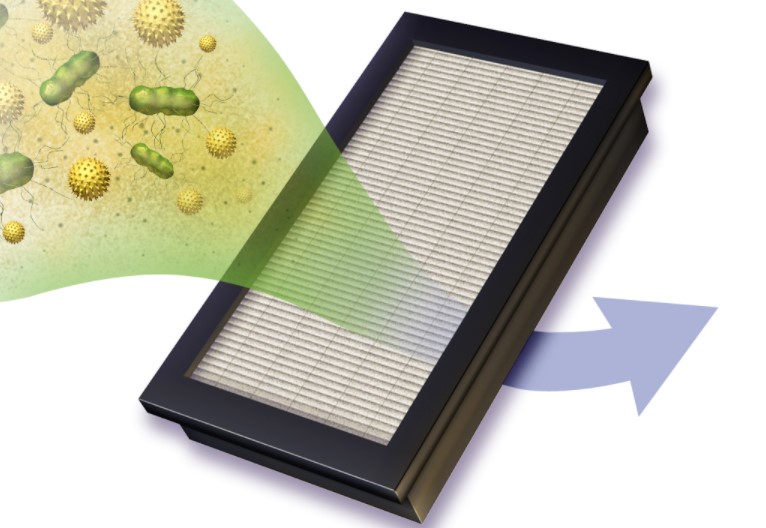High efficiency particulate arrestance HEPA

|
Contents |
[edit] Introduction
High efficiency particulate arrestance, or HEPA, is a method of air filtration incorporated into a specific type of pleated mechanical particulate absorbing air filter. Due to the mechanical nature of their operations, HEPA purifiers are effective in environments where medical conditions such as asthma or allergies may be prevalent.
[edit] HEPA parameters
To qualify as a HEPA filter, the device must remove 99.95% (EU standard) or 99.97% (ASME, US DOE) of dust, pollen, mould, bacteria and airborne particles with a size of 0.3 microns (µm) from the air that passes through it. However, the term is sometimes used to market products that may not comply with this HEPA standard.
This value is used for filter classification because it is close to the most penetrating particle size (MPPS) of approximately 0.2-0.3 μm (NASA). Particles that are larger or smaller than the MPPS are filtered more efficiently than the rated efficiency, although in some circumstances particles below the MPPS may act as nucleation sites and form particles close to the MPPS.
HEPA filters first became available in the 1950s, but their effectiveness was not technically rated until after the introduction of the minimum efficiency reporting value (MERV) rating system. MERV was developed in the 1980s by the American Society of Heating, Refrigerating and Air-Conditioning Engineers (ASHRAE).
For more information, see Minimum efficiency reporting value MERV.
Using a range from 1 to 20, the MERV rating system reflects the measurement of a filter’s arrestance - or its ability to remove dust from the air - relative to how many of a specific size dust particle (within the range of 0.3 to 10 µm) need to be removed to keep HVAC equipment clean. The higher the MERV rating, the better the filter is at trapping specific types of particles.
In January 2009, ASHRAE stopped recognising general air filters with MERV values based on ratings in the 17 to 20 range. This range is instead represented by HEPA and ultra low particulate air (ULPA) filters, which are capable of removing extremely high levels of dust particles as well as some viruses and other dangerous airborne particulates.
[edit] Proper care and operations of HEPA filters
Appropriate operating conditions are needed in order for HEPA filters to perform as designed. These parameters include velocity and direction of airflow, particle concentration, particle size distribution and appropriate temperature and humidity levels. Design factors, such as non-uniformity of filter pleats or improper filter installation, can also have an impact on the efficiency of these devices.
HEPA filters also need to be inspected and changed on a regular basis. The period between replacement may vary on the setting and the demands of the environment. If the filters are not maintained properly, they will no longer operate efficiently and may even have a negative impact on both the people and the equipment that they are meant to protect.
[edit] HEPA filters and COVID-19
Since COVID-19 is 50 to 200 nanometres in size, it is smaller than the MPPS of HEPA filters, and thus the filter should be able to remove it with at least the rated efficiency.
HEPA filters are not designed to kill viruses and bacteria, which can stay in the filter as long as they survive. This can be up to nine days for COVID-19 in certain conditions. However, COVID-19 survives best on hard surfaces and tends to die faster on soft, porous materials such as filter media.
[edit] Related articles on Designing Buildings
- Air filtration.
- Air filtration and clean indoor air quality standards.
- American Society of Heating and Air-conditioning Engineers.
- Arrestance.
- Building ventilation and COVID-19 transmission risk.
- Clean indoor air for healthy living - New air filter standards.
- Designing HVAC to resist harmful microorganisms.
- Indoor air quality.
- Minimum efficiency reporting value MERV.
Featured articles and news
RTPI leader to become new CIOB Chief Executive Officer
Dr Victoria Hills MRTPI, FICE to take over after Caroline Gumble’s departure.
Social and affordable housing, a long term plan for delivery
The “Delivering a Decade of Renewal for Social and Affordable Housing” strategy sets out future path.
A change to adoptive architecture
Effects of global weather warming on architectural detailing, material choice and human interaction.
The proposed publicly owned and backed subsidiary of Homes England, to facilitate new homes.
How big is the problem and what can we do to mitigate the effects?
Overheating guidance and tools for building designers
A number of cool guides to help with the heat.
The UK's Modern Industrial Strategy: A 10 year plan
Previous consultation criticism, current key elements and general support with some persisting reservations.
Building Safety Regulator reforms
New roles, new staff and a new fast track service pave the way for a single construction regulator.
Architectural Technologist CPDs and Communications
CIAT CPD… and how you can do it!
Cooling centres and cool spaces
Managing extreme heat in cities by directing the public to places for heat stress relief and water sources.
Winter gardens: A brief history and warm variations
Extending the season with glass in different forms and terms.
Restoring Great Yarmouth's Winter Gardens
Transforming one of the least sustainable constructions imaginable.
Construction Skills Mission Board launch sector drive
Newly formed government and industry collaboration set strategy for recruiting an additional 100,000 construction workers a year.
New Architects Code comes into effect in September 2025
ARB Architects Code of Conduct and Practice available with ongoing consultation regarding guidance.
Welsh Skills Body (Medr) launches ambitious plan
The new skills body brings together funding and regulation of tertiary education and research for the devolved nation.
Paul Gandy FCIOB announced as next CIOB President
Former Tilbury Douglas CEO takes helm.
UK Infrastructure: A 10 Year Strategy. In brief with reactions
With the National Infrastructure and Service Transformation Authority (NISTA).






















